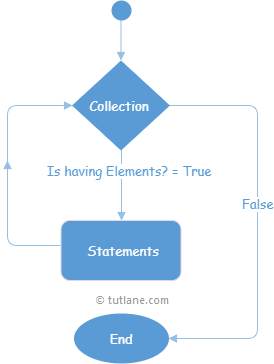In Visual Basic, For Each loop is useful to loop through items in an array or collection object to repeatedly execute the block of statements.
In Visual Basic For Each loop will work with the collection objects such as an array, list, etc., to execute the block of statements for each element in the array or collection.
After iterating through each element in a collection, control will transfer to the next statement of the following For Each block.
In Visual Basic, we can use Exit, Continue statements within For Each loop to exit or continue to the next iteration of the loop based on our requirements.
Following is the syntax of defining the For Each loop in Visual Basic programming language.
If you observe the above syntax, we defined For Each loop with a collection object and required variable name to access elements from the collection object.
Here, Data_Type is a built-in data type or custom class type, and var_name is a variable name to access elements from the collection object (Collection_Object) to use in the body of For Each loop.
Following is the pictorial representation of For Each loop process flow diagram in Visual Basic programming language.

Now, we will see how to use For Each loop in a visual basic programming language with examples.
Following is the example of using For Each loop in a visual basic programming language to iterate or loop through array elements.
If you observe the above example, we created a string array object “names”. We looped through each element of the array object using For Each loop and assigning array elements to the string variable “name”.
To know more about arrays in a visual basic programming language, check Visual Basic arrays with examples.
When we execute the above Visual Basic program, we will get the result as shown below.
If you observe the above result, we iterated through each array element and printed those values on the console window based on our requirements.
Same as For Each with arrays, we can use For Each loop with list object to process each element in the list object, but inside For Each loop, it won’t allow us to modify (add or delete) the list object items.
To learn more about lists in visual basic programming, check Visual Basic lists with examples.
Following is the example of using For Each loop in a visual basic programming language to iterate or loop through list elements.
If you observe the above example, we created and added the string elements to the names list object. Here, we used For Each to loop through the items in the list to print it on the console window.
When we execute the above visual basic program, we will get the result below.
This is how we can use For Each loop in a visual basic programming language to loop through each element in the array or collection objects based on our requirements.